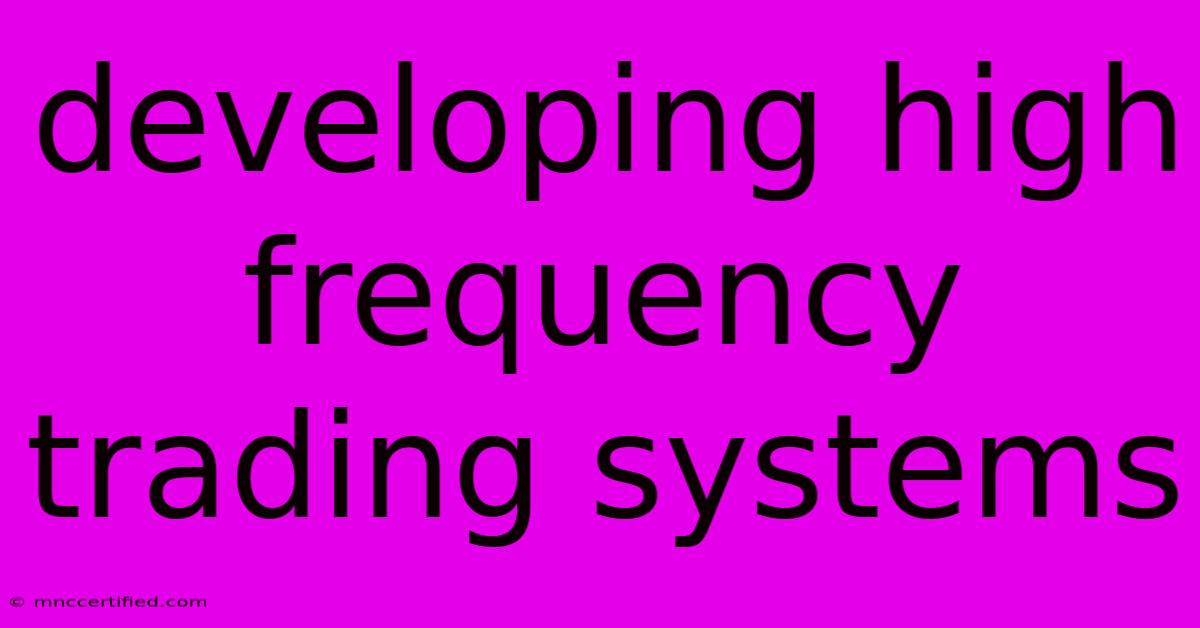Developing High Frequency Trading Systems

Table of Contents
Developing High-Frequency Trading Systems: A Guide for Aspiring Traders
High-frequency trading (HFT) has become increasingly popular in recent years, offering investors the potential for significant returns. But what exactly is HFT, and how can you develop your own system? This guide will dive into the world of HFT, exploring its intricacies and providing valuable insights for those looking to build a successful high-frequency trading system.
Understanding High-Frequency Trading
HFT involves using powerful algorithms to execute trades at lightning speed, exploiting tiny price discrepancies in the market. These systems analyze massive amounts of data, identifying patterns and executing trades in milliseconds. HFT relies on speed, automation, and sophisticated algorithms to gain a competitive edge.
Key characteristics of HFT systems:
- Speed: Millisecond execution times are crucial.
- Automation: Trading decisions are made automatically by algorithms.
- Data-intensive: Analyze vast amounts of market data in real-time.
- Scalability: Capable of handling large volumes of trades simultaneously.
- Sophisticated algorithms: Employ complex strategies to exploit market inefficiencies.
Building Your HFT System: A Step-by-Step Approach
Developing an HFT system is a complex process, requiring expertise in various domains, including:
1. Defining Your Trading Strategy:
- Identify market inefficiencies: Research and pinpoint opportunities for profitable trading.
- Develop your algorithm: Design an algorithm that can capitalize on these inefficiencies.
- Backtesting and optimization: Test your strategy on historical data to evaluate its performance.
2. Selecting the Right Technology:
- Programming languages: Python, C++, Java are common choices for HFT systems.
- Trading platforms: Choose a platform that offers low latency and high-performance execution.
- Hardware: Invest in powerful servers and high-speed network connections for efficient data processing and trade execution.
3. Data Management and Analysis:
- Data sources: Access real-time market data from reputable providers.
- Data storage and processing: Utilize efficient databases and analytical tools to manage and analyze data.
- Market analysis: Develop methods for identifying trends, patterns, and opportunities.
4. Risk Management:
- Define your risk tolerance: Set clear limits on potential losses.
- Implement risk mitigation strategies: Employ techniques like stop-loss orders and position limits to minimize risk.
- Monitor and manage risk: Continuously track your trades and adjust your strategies as needed.
5. Testing and Deployment:
- Paper trading: Test your system with simulated trades before deploying it in the live market.
- Monitoring and optimization: Continuously monitor the system's performance and adjust it based on real-world data.
- Deployment: Deploy your system to a live trading environment, ensuring robust security measures.
Challenges of HFT Development
- High development costs: Building an HFT system requires significant capital investment in software, hardware, and expertise.
- Regulatory challenges: The fast-paced nature of HFT attracts regulatory scrutiny, demanding compliance with various rules and regulations.
- Competition: The HFT market is fiercely competitive, with sophisticated players constantly developing new strategies and technologies.
- Technological complexity: Building and maintaining an HFT system requires advanced technical skills and a deep understanding of market dynamics.
Conclusion: Navigating the HFT Landscape
Developing a high-frequency trading system is a demanding but rewarding endeavor. With careful planning, thorough testing, and a commitment to continuous improvement, aspiring traders can navigate the complexities of the HFT world and potentially achieve significant returns. Remember to prioritize risk management and stay informed about market developments and regulatory changes to ensure your system remains competitive and profitable.

Thank you for visiting our website wich cover about Developing High Frequency Trading Systems. We hope the information provided has been useful to you. Feel free to contact us if you have any questions or need further assistance. See you next time and dont miss to bookmark.
Featured Posts
-
Republicans Control Wisconsin Legislature Voting Impact
Nov 07, 2024
-
Visitors Insurance Fixed Vs Comprehensive
Nov 07, 2024
-
Trump Victory Boosts Dogecoin Prices
Nov 07, 2024
-
Naics Code For Investment Holding Company
Nov 07, 2024
-
Broad Form Auto Insurance Washington State
Nov 07, 2024